Podcast
Questions and Answers
What is the primary goal of copyright?
What is the primary goal of copyright?
- To facilitate piracy
- To limit software distribution
- To restrict software usage
- To encourage creators to produce new works (correct)
What does GPL stand for in software licensing?
What does GPL stand for in software licensing?
- Global Public License
- General Private License
- Generic Public License
- General Public License (correct)
What is the function of uninstalling software?
What is the function of uninstalling software?
- To disable the software temporarily
- To ensure that all associated files are removed from the computer (correct)
- To merely delete the executable file from the system
- To upgrade software to a newer version
What is typically required during software installation?
What is typically required during software installation?
What is the primary function of the File Allocation Table (FAT)?
What is the primary function of the File Allocation Table (FAT)?
Which function of the operating system is responsible for controlling the resources required by running programs?
Which function of the operating system is responsible for controlling the resources required by running programs?
Which type of software is necessary for running a computer?
Which type of software is necessary for running a computer?
What purpose do patches serve in software updating?
What purpose do patches serve in software updating?
What type of information does the operating system’s indexing of files include?
What type of information does the operating system’s indexing of files include?
In terms of storage management, how does the operating system organize files on a storage device?
In terms of storage management, how does the operating system organize files on a storage device?
What is a service pack in terms of software updates?
What is a service pack in terms of software updates?
What kind of software provides the graphical user interface for users to interact with a computer?
What kind of software provides the graphical user interface for users to interact with a computer?
What does memory management in an operating system primarily control?
What does memory management in an operating system primarily control?
What is the primary function of a device driver?
What is the primary function of a device driver?
What does 'plug-and-play' technology allow for?
What does 'plug-and-play' technology allow for?
Which type of operating system is specifically designed for a single purpose?
Which type of operating system is specifically designed for a single purpose?
What is a key feature of a hot-swappable device?
What is a key feature of a hot-swappable device?
Which operating system type can manage multiple users and resources across a network?
Which operating system type can manage multiple users and resources across a network?
What is the role of a graphical user interface (GUI) in an operating system?
What is the role of a graphical user interface (GUI) in an operating system?
In terms of driver installation, what happens if the necessary drivers are not included in the operating system?
In terms of driver installation, what happens if the necessary drivers are not included in the operating system?
Which of these is not a function of an operating system?
Which of these is not a function of an operating system?
What is the primary purpose of utility programs?
What is the primary purpose of utility programs?
Which of the following tasks does a disk clean-up utility perform?
Which of the following tasks does a disk clean-up utility perform?
What is the primary benefit of compressing files?
What is the primary benefit of compressing files?
How does disk defragmentation affect file access time?
How does disk defragmentation affect file access time?
What happens to file clusters as a result of constant file editing and deleting?
What happens to file clusters as a result of constant file editing and deleting?
What is the main difference between lossy and lossless compression?
What is the main difference between lossy and lossless compression?
Why is fragmentation considered a problem with traditional HDDs but not with SSDs?
Why is fragmentation considered a problem with traditional HDDs but not with SSDs?
What does a backup utility maintain?
What does a backup utility maintain?
What distinguishes free open-source software (FOSS) from proprietary software?
What distinguishes free open-source software (FOSS) from proprietary software?
Which of the following is NOT an advantage of proprietary software?
Which of the following is NOT an advantage of proprietary software?
What is a major disadvantage of open-source software?
What is a major disadvantage of open-source software?
What is a characteristic of shareware software?
What is a characteristic of shareware software?
Which scenario exemplifies shrink-wrap software?
Which scenario exemplifies shrink-wrap software?
What is a potential risk associated with using open-source software?
What is a potential risk associated with using open-source software?
What does a proprietary software vendor typically offer that is not common in free software distribution?
What does a proprietary software vendor typically offer that is not common in free software distribution?
Which of these statements is true regarding freeware?
Which of these statements is true regarding freeware?
Flashcards are hidden until you start studying
Study Notes
Software Distribution Models
- Proprietary Software: Software owned by a company, requires a license for use. Examples: Adobe Photoshop, Microsoft Windows
- Advantages: Stable, tested, easy support access
- Disadvantages: Must purchase, limited sharing, no access to source code, reliance on developer for fixes
- Open Source Software: Source code available for modification and distribution, typically free of charge. Examples: OpenOffice, Linux, VLC Media Player
- Advantages: Free or low cost, collaborative bug fixing, potential for feature additions
- Disadvantages: Less user-friendly, limited support, potential for vulnerabilities
- Shareware: Trial version of proprietary software, often with limited features or time usage. Examples: Various software programs
- Freeware: Free software without limitations. Often distributed under a GPL (General Public License) allowing modification and redistribution.
Software Categories
- System Software: Programs that manage and control computer operations, essential for computer function. Examples: Operating System, Utility programs
- Application Software: Programs designed for specific user tasks. Examples: Word processors, graphic design software
Software Piracy
- Illegal copying, distribution, or use of software (intellectual property).
- Detrimental to software developers, hindering innovation and financial incentives.
Software Installation and Uninstallation
- Installation: Adding a new program to the computer. Typically involves running an installer program, accepting terms and conditions (EULA), and potentially requiring an activation key.
- Uninstallation: Removing software from the computer. Requires using the uninstall feature to ensure complete removal of all files associated with the program.
Software Updating
- Updating software addresses bugs, adds new features, and enhances security.
- Patch: A small update to fix bugs.
- Service Pack: A package containing multiple patches released over a period of time.
Utility Programs
- Programs for managing, maintaining, and securing the computer.
- Archiving: Compressing and storing outdated files for retrieval.
- Backup: Creating duplicate copies of files for data recovery.
- Disk Cleanup: Removes unnecessary files like temporary internet downloads, deleted files from the recycle bin, unused Windows components, and uninstalled programs.
- Compression (WinZip, WinRAR): Reducing file size through compression, requiring decompression for use.
- Disk Defragmentation (HDD Only): Reorganizes file clusters on a hard drive to improve file access speed.
Device Drivers
- Programs that allow the operating system to communicate with hardware devices.
- Automatic Driver Installation (Plug and Play): Devices are automatically detected and configured, requiring no manual intervention.
- Manual Driver Installation: Drivers must be manually installed if not included in the operating system, often downloaded from the internet.
Types of Operating Systems
- Embedded Operating System: Operating systems stored on internal memory chips, designed for specific tasks in devices such as ATMs, POS systems, e-readers, traffic lights, and TVs.
- Network Operating System: Operating systems designed for managing and sharing resources, communication, security, and multiple users in a network environment. Examples: Unix, Linux, Microsoft Server
- Stand-Alone Operating System: Operating systems that run on PCs, laptops, and notebooks, managing hardware and software.
Operating System Functions
- Graphical User Interface (GUI): Provides visual controls for user interaction with the computer and software.
- Input/Output Control (Device Management): Manages input and output devices, communicating between hardware and software (assisted by device drivers).
- Disk Management (Storage/File System Management): Organizes files on storage devices and manages access to them.
- Memory Management (RAM): Manages RAM usage and allocates virtual memory when needed.
- Process and Task Management (CPU): Manages CPU resources, scheduling programs and tasks.
File Storage and Information Management
- FAT (File Allocation Table): An index that records the location of files on a storage medium.
- Indexing of Files: A database that stores file and folder names, size, date modified, and text content (meta-data) for file searching.
Studying That Suits You
Use AI to generate personalized quizzes and flashcards to suit your learning preferences.




